

Breaking the binary by coming out as a trans scientist. COVID and 2020: An extraordinary year for science. By Ewen Callaway, Heidi Ledford, Giuliana Viglione, Traci Watson, & Alexandra Witze.

One event dominated in 2020: a deadly and previously unknown virus wreaked havoc across the globe, killing more than 1.5 million people, infecting many more and causing economic devastation. And although there were other newsworthy research developments in 2020, the pandemic set the course of science to an extraordinary degree.
The speed of the coronavirus’s spread has been matched only by the pace of scientific insights. Almost as soon as SARS-CoV-2 was discovered, research groups worldwide started probing its biology, while others developed diagnostic tests or investigated public-health measures to control it. Indigenous trackers are teaching scientists about wildlife. Few can claim to have a more intimate knowledge of their land and its fauna than the San trackers of the Kalahari, a large semi-arid region spanning parts of Botswana, Namibia and South Africa.
Thousands of years of hunter-gathering expertise have been handed down from one generation to the next. It's a valuable knowledge pool that is often overlooked by science, argues Louis Liebenberg. For over 20 years, Liebenberg, an associate of human evolutionary biology at Harvard University, has been connecting indigenous San groups in Namibia with scientists all over the world. And long before the advent of social media, he did it with an app. As executive director of CyberTracker Conservation, the South African developed a piece of free software that allows animal trackers in the Kalahari to share tracking insights and create better data on biodiversity.
Carl Sagan: Christmas lectures 2 - The Outer Solar System and Life. Global Warming Policy Foundation. The Global Warming Policy Foundation (GWPF) is a lobby group in the United Kingdom whose stated aims are to challenge "extremely damaging and harmful policies" envisaged by governments to mitigate anthropogenic global warming.[2] The GWPF as well as some of its prominent members have been characterized as promoting climate change denial.[3][4] In 2014, when the Charity Commission ruled that the GWPF had breached rules on impartiality, a non-charitable organisation called the "Global Warming Policy Forum" was created as a wholly owned subsidiary, to do lobbying that a charity could not.
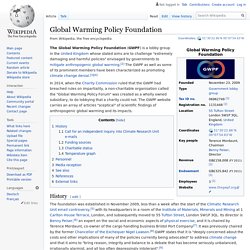
The GWPF website carries an array of articles "sceptical" of scientific findings of anthropogenic global warming and its impacts. History[edit] Freeman Dyson. Planet Is Screwed, Says Bank That Screwed the Planet. The most important thing, he emphasized, is that there is no magic number.
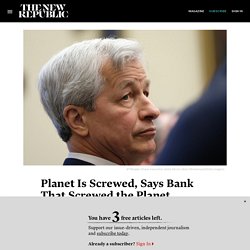
“It could be $200 per ton or $400 per ton,” he said. “There are so many uncertainties that presenting one number is just insane. It’s uncomfortable for an economist to say, but the grand conclusion is a bit of humility. We can’t tell you the grand solution. Everything we know about how to price a ton of carbon dioxide tells us that it seems to be much, much worse than the standard climate economy models tell us.” In 2019, a report from the Rainforest Action Network and several other groups found that JP Morgan Chase was by far the world’s most generous bank backer of fossil fuels, having financed $196 billion worth of coal, oil, and gas projects between 2016 and 2018.
The JP Morgan report doesn’t include clear recommendations for what the company’s own risk analysts should do with the information presented. Predatory publishing. Fraudulent business model for scientific publications "Think.

Check. Submit. " poster by an international initiative to help researchers avoid predatory publishing Predatory publishing, also write-only publishing[1][2] or deceptive publishing,[3] is an exploitative academic publishing business model that involves charging publication fees to authors without checking articles for quality and legitimacy, and without providing editorial and publishing services that legitimate academic journals provide, whether open access or not. Reality. Not to be confused with Realty.
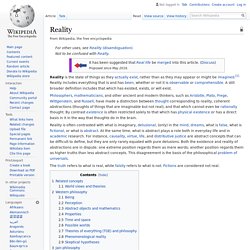
Philosophers, mathematicians, and other ancient and modern thinkers, such as Aristotle, Plato, Frege, Wittgenstein, and Russell, have made a distinction between thought corresponding to reality, coherent abstractions (thoughts of things that are imaginable but not real), and that which cannot even be rationally thought. By contrast existence is often restricted solely to that which has physical existence or has a direct basis in it in the way that thoughts do in the brain. Reality is often contrasted with what is imaginary, delusional, (only) in the mind, dreams, what is false, what is fictional, or what is abstract. Interpretations of quantum mechanics. An interpretation of quantum mechanics is an attempt to explain how the mathematical theory of quantum mechanics "corresponds" to reality.

Although quantum mechanics has held up to rigorous and extremely precise tests in an extraordinarily broad range of experiments (not one prediction from quantum mechanics is found to be contradicted by experiments), there exist a number of contending schools of thought over their interpretation. These views on interpretation differ on such fundamental questions as whether quantum mechanics is deterministic or random, which elements of quantum mechanics can be considered "real", and what is the nature of measurement, among other matters.
Despite nearly a century of debate and experiment, no consensus has been reached amongst physicists and philosophers of physics concerning which interpretation best "represents" reality.[1][2] History[edit] Wave function collapse. Process by which a quantum system takes on a definitive state In 1927, Werner Heisenberg used the idea of wave function reduction to explain quantum measurement.[5] However, if collapse were a fundamental physical phenomenon, rather than just the epiphenomenon of some other process, it would mean nature was fundamentally stochastic, i.e. nondeterministic, an undesirable property for a theory.[2][6][7] This issue remained until quantum decoherence entered mainstream opinion after its reformulation in the 1980s.[2][4][8] Decoherence explains the perception of wave function collapse in terms of interacting large- and small-scale quantum systems.[9] Mathematical description[edit] Mathematical background[edit]
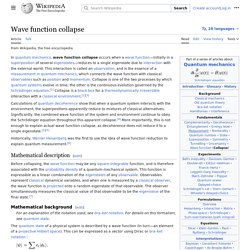
Evolutionary history of life. The processes by which organisms evolved on Earth The evolutionary history of life on Earth traces the processes by which living and fossil organisms evolved, from the earliest emergence of life to the present.
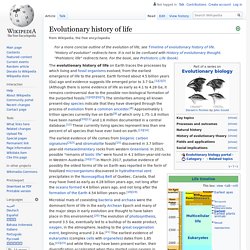
Darwin's finches. Group of related bird species in the Galápagos Islands The term "Darwin's finches" was first applied by Percy Lowe in 1936, and popularised in 1947 by David Lack in his book Darwin's Finches.[7][8] Lack based his analysis on the large collection of museum specimens collected by the 1905–06 Galápagos expedition of the California Academy of Sciences, to whom Lack dedicated his 1947 book.
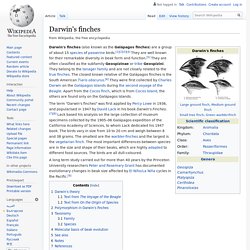
The birds vary in size from 10 to 20 cm and weigh between 8 and 38 grams. The smallest are the warbler-finches and the largest is the vegetarian finch. Sodium/potassium/calcium exchanger 5. Sodium/potassium/calcium exchanger 5 (NCKX5), also known as solute carrier family 24 member 5 (SLC24A5), is a protein that in humans is encoded by the SLC24A5 gene that has a major influence on natural skin colour variation.[5] The NCKX5 protein is a member of the potassium-dependent sodium/calcium exchanger family. Sequence variation in the SLC24A5 gene, particularly a non-synonymous SNP changing the amino acid at position 111 in NCKX5 from alanine to threonine, has been associated with differences in skin pigmentation.[6] The SLC24A5 gene's derived threonine or Ala111Thr allele (rs1426654[7]) has been shown to be a major factor in the light skin tone of Europeans compared to Sub-Saharan Africans, and is believed to represent as much as 25–40% of the average skin tone difference between Europeans and West Africans.[5][8] It has been the subject of recent selection in Europe, and is fixed in European populations.[9][10][11] Gene[edit] Protein[edit] Effect on skin color[edit] See also[edit]
Environmental economics. Environmental economics is a sub-field of economics concerned with environmental issues. It has become a widely studied topic due to growing environmental concerns in the twenty-first century. Environmental Economics "...undertakes theoretical or empirical studies of the economic effects of national or local environmental policies around the world ... . Particular issues include the costs and benefits of alternative environmental policies to deal with air pollution, water quality, toxic substances, solid waste, and global warming. Rebound effect (conservation) In conservation and energy economics, the rebound effect (or take-back effect) is the reduction in expected gains from new technologies that increase the efficiency of resource use, because of behavioral or other systemic responses.
These responses usually tend to offset the beneficial effects of the new technology or other measures taken. Super conservation (RE < 0): the actual resource savings are higher than expected savings – the rebound effect is negative. This occurs if the increase in efficiency reduces costs.Zero rebound (RE = 0): The actual resource savings are equal to expected savings – the rebound effect is zero.Partial rebound (0 < RE < 1): The actual resource savings are less than expected savings – the rebound effect is between 0% and 100%. This work provided a theoretical grounding for empirical studies and played an important role in framing the problem of the rebound effect. Direct and Indirect Effects. Antifreeze. Coolant additive which reduces the freezing point of water "Topping up" the antifreeze solution in a car's cooling system is a routine maintenance item for most modern cars. An antifreeze is an additive which lowers the freezing point of a water-based liquid.
An antifreeze mixture is used to achieve freezing-point depression for cold environments. Common antifreezes increase the boiling point of the liquid, allowing higher coolant temperature.[1] Michael Faraday. English scientist. Luigi Galvani. William Gilbert (physician) Timperleys, the 15th-century home of the Gilberd family in Colchester.
How accurate are scientific predictions about climate? Amazon threatened to fire employees who spoke out against its environmental policies. Amazon says that it’s a company committed to fighting climate change, and recently it pledged to drastically reduce its carbon emissions over the next 20 years. Thermal physics. Thermal physics is the combined study of thermodynamics, statistical mechanics, and kinetic theory of gases. This umbrella-subject is typically designed for physics students and functions to provide a general introduction to each of three core heat-related subjects. Other authors, however, define thermal physics loosely as a summation of only thermodynamics and statistical mechanics.[1]
Microstate (statistical mechanics) Ludwig Boltzmann. Endothermic process. Exothermic reaction. Chemical reaction that releases energy as light or heat. Behavioral ecology. Essentialism. Natural selection. Gauge theory. Assistens Cemetery (Copenhagen) Niels Bohr. Copenhagen interpretation. Gilbert N. Lewis. Nanosecond. Picosecond. Quantum realm. Identical particles. Pauli exclusion principle. Thomas Carlos Mehen. Color confinement. Eta meson. Timeline of particle discoveries. Omega baryon. Lorentz covariance. Wet-bulb temperature. Bandar-e Mahshahr. Antofagasta Region. Atacama Desert. West Maui Mountains. My Top 10 Columns of the Decade. Snowflake. Amazon Deforestation Rates More Than Doubled in 2019. Is Your Plastic Actually Being Recycled? Early humans domesticated themselves, new genetic evidence suggests.
Why Climate Alarmism Hurts Us All. Snow paradox: Why 2 cm of snow can actually be worse than 25 cm. UPDATE: Missing 87-year-old Vancouver man with dementia located. "20 Women Who Changed Science. And The World" by Hydrogene. Scientists: Earth Endangered by New Strain of Fact-Resistant Humans. The Most Important Moment in the History of Life. Why People Don't Believe In Climate Science. Carl Sagan attempts to debate with a creationist. Paradigm. 30 Amazing Facts You Didn't Know About The Human Body. Earthquake Facts That Will Shake You To The Core. 25 Accidental Discoveries That You Should Be Thankful For. DISTORTIONS. The Deep Future: Crash Course Big History #10.
3 Time Travel Paradoxes!! Space and Astronomy. Making Sense of the Chemistry That Led to Life on Earth.